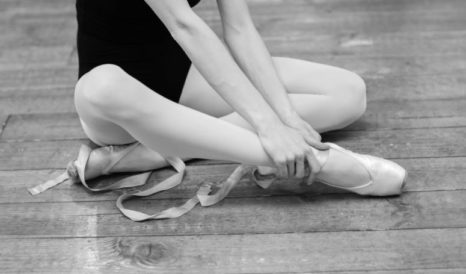Common Dance Injuries
Dancers are exposed to a wide range of risk factors for injury. Here, we discuss the most common dance injuries and how they can be treated.
Professional dancers know what it takes. Along with the physical stamina for their gruelling training, dancers need incredible psychological resilience to cope in an industry that is constantly assessing their bodies, to perform on stage alone or as part of a team, and to deal with relentless competition and auditions just to pay the bills.

It is that combination of mental and physical resilience that can lead to problems. Dancers are expected to carry on training and working even if their feet and ankles are killing them, even if their toes are bruised or they’ve wrenched a muscle. Every ballet dancer will tell you that they’ve experienced repetitive strain at the very least – from repeating the same moves in rehearsal over and over again.
Muscle inflammation or tension is usually a warning sign to rest and stop for a while, allowing your body to recover. But dancers rarely get time to rest during rehearsals, and often go straight from one show to another. When the body doesn’t have time to heal itself, even minor injuries can lead to major musculoskeletal issues.
While many injuries suffered by dancers are typical of the problems dealt with by sports medicine clinics – ankle sprains, lumbar strains and injuries caused by falls and collisions – there are many other conditions that are particular to dancers. On top of that, each dance style has its own risk factors: whether it’s ballet or street dance.
Common Dance Related Injuries
Some of the most common dance injures include:
- Hip injuries: hip impingement, hip flexor tendonitis, labral tears, hip bursitis and sacroiliac joint dysfunction
- Foot and ankle injuries: footballer’s ankle, Achilles tendonitis, hallux rigidus, Morton’s neuroma, bunions
- Knee injuries: patellofemoral pain syndrome, meniscus tears, patellar tendinitis
- Stress fractures: metatarsals (foot bones), tibia (shin splints), sesamoids (bones at the ball of your foot) and lumbar spine (lower back).
An experienced orthopaedic consultant will carry out a physical evaluation and assessment specific to the dancer. More than ever, the diagnosis, treatment and rehab must fit the individual’s needs – namely, getting dancers back to work as quickly as possible, while improving long-term strength, mobility and physical resilience.
Dance-focused sports medicine focuses on finding the right treatment – whether it’s injections to reduce joint inflammation and promote healing, targeted physiotherapy, or surgery to repair ligament or bone damage. More importantly, for a dancer, the rehabilitation needs to look at improving technique to prevent ongoing micro-traumas, strains or joint problems.
Simon Moyes and the Capital Orthopaedics team have worked with many dance professionals over the years. With an in-depth understanding of the requirements and specialised physical demands of the job, they are able to assess, diagnose and treat all dance-related injuries and conditions.
Actor and dancer, Olivia Holding gives her injury low-down
Repetitive strain usually comes out as the most common cause of musculoskeletal problems in dancers. ‘No matter how much you stretch and strengthen prior to dancing,’ says Olivia Holding, ‘Doing the same movement over and over again will always be a shock to the particular muscle or muscle group.’
Many dance stages are on a slope – known as a ‘raked stage’ – to give the audience a better view of the ensemble. This slight downslope can lead to lower back pain and / or calf strain in dancers.
If a dancer is lucky enough to avoid fractures throughout their career, then injuries are predominantly muscular. ‘I have suffered from a rib fracture in the past. Unfortunately, the best treatment is rest. Once they are healed, then you can start to think about rehabilitation, including resistance band work and strengthening the muscles around the ribs.’
Neck strain is another issue for Olivia. ‘Acupuncture works best for me,’ she says. ‘Massage can aggravate the muscle and cause it to flare up before it improves. If I’m going back out on stage after treatment, acupuncture releases the tension without any muscle distress, which means I can use the muscle again a few hours later.’
Like most dancers, Olivia has her own techniques to prevent injuries.
‘To help my knees, I SWEAR by foam rolling my quadriceps and glutes.’ She also uses foam rolling for her lower back: ‘Rolling out the quadriceps prevents a lot of lower back pain – which people don’t often link to being the cause of lumbar pain.’
Shin splints are particularly common when dancing in heels, says Olivia. ‘I use a cricket ball into deep tissue in my calves to prevent shin splints – especially when dancing in heels eight shows a week.’
‘Yoga and pilates are great, too,’ she adds, ‘They keep the muscles lengthening and prevent over bulking, in particular the quadriceps.’
Simon Moyes is an internationally renowned orthopaedic surgeon and leader in the field of arthroscopic (keyhole) surgery. His Capital Orthopaedics team works from The Cromwell Hospital in London, with its state-of-the-art diagnostic and surgical equipment, and top sports medicine professionals. Contact Simon Moyes for an expert diagnosis and treatment of all your musculoskeletal problems.
